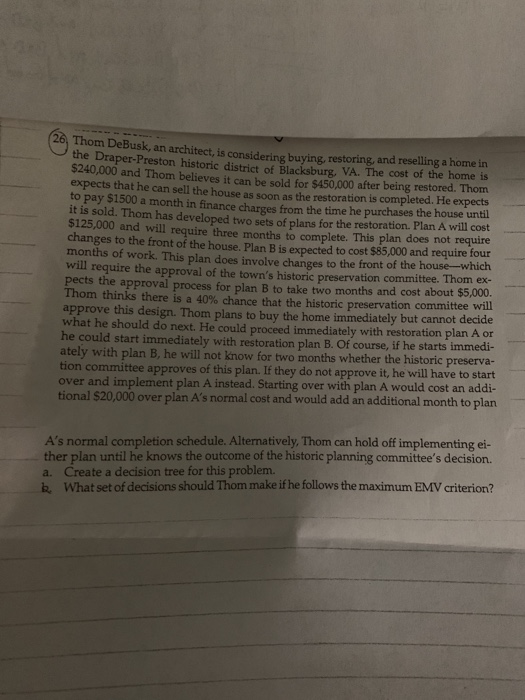Create table showing EOL,EMV, Treeplan

4 Up 5 6 Thom DeBusk, an architect, is considering buying, restoring, and reselling a home in the Draper-Preston historic district of Blacksburg, VA. The cost of the home is $240,000 and Thom believes it can be sold for $450,000 after being restored. Thom expects that he can sell the house as soon as the restoration is completed. He expects to pay $1500 a month in finance charges from the time he purchases the house until it is sold. Thom has developed two sets of plans for the restoration. Plan A will cost $125,000 and will require three months to complete. This plan does not require changes to the front of the house. Plan B is expected to cost $85,000 and require four months of work. This plan does involve changes to the front of the house-which will require the approval of the town's historic preservation committee. T pects the approval process for plan B to take two months and cost about $5,000 Thom thinks hom ex- there is a 40% chance that the historic preservation committee will approve this design. Thom plans to buy the home immediately but cannot decide what he should do next. He could proceed immediately with restoration plan A or he could start immediately with restoration plan B. Of course, if he starts immedi- ately with plan B, he will not know for two months whether the historic preserva- tion committee approves of this plan. If they do not approve it, he will have to start over and implement plan A instead. Starting over with plan A would cost an adodi tional $20,000 over plan A's normal cost and would add an additional month to plan A's normal completion schedule. Alternatively, Thom can hold off implementing ei- ther plan until he knows the outcome of the historic planning committee's decision. a. Create a decision tree for this problem. What set of decisions should Thom make if he follows the maximum EMV criterion? Thom DeBusk, an architect, is considerin the g buying, restoring, and reselling a home in Draper-Preston historic district of Blacksburg, VA. The cost of the home is $240,000 and Thom believes it can be sold for $450,000 after being restored. Thom expects that he can sell the house as soon as the restoration is completed. He expects to pay $1500 a month in finance charges from the time he purchases the house until it is sold. Thom has developed two sets of plans for the restoration. Plan A will cost $125,000 and will require three months to complete. This plan does not require changes to the front of the house. Plan B is expected to cost $85,000 and require four months of work. This plan does involve changes to the front of the house-which will require the approval of the town's historic preservation committee. Thom ex- pects the approval process for plan B to take two months and cost about $5,000. Thom thinks there is a 40% chance that the historic preservation approve this design. Thom plans to buy the home immediately but cannot decide what he should do next. He could proceed immediately with restoration plan A or he could start immediately with restoration plan B. Of course, if he starts immedi- ately with plan B, he will not know for two months whether the historic preserva- tion committee approves of this plan. If they do not approve it, he will have to start over and implement plan A instead. Starting over with plan A would cost an addi- tional $20,000 over plan A's normal cost and would add an additional month to plan committee will A's normal completion schedule. Alternatively, Thom can hold off implementing ei- ther plan until he knows the outcome of the historic planning committee's decision. a. Create a decision tree for this problem. b What set of decisions should Thom make if he follows the maximum EMV criterion









